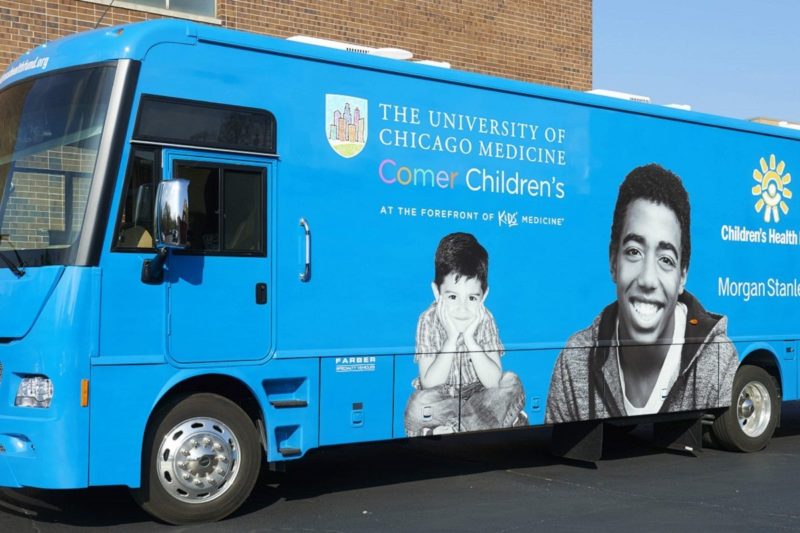How Mobile Health Units Aim to Revolutionize Reproductive Care in Chicago’s Underserved Communities
Unequal access to transportation and housing disenfranchises many low-income communities. Teenagers who attempt to obtain medical care often experience these inequalities in a heightened way given that they often lack the time, money, and autonomy required to seek the care and information they need.

Nationally, births to teenage mothers are at an all-time low. But there is still work to be done: This decrease in teenage pregnancy has not affected all states and communities equally.
One way to address the structural barriers that may be leading to disparities in reproductive health, including unwanted teenage pregnancy, is to bring adolescent care to the areas that need it most through mobile health units (MHUs), clinics on wheels that provide select health services.
In recent years, MHUs have gained traction in the United States and countries around the world. The use of MHUs, particularly in rural and under-resourced areas, increases ease of access and provides privacy and confidentiality. School-based MHUs, for example can reduce time spent away from school. Nationally, this model has shown great promise in reducing trips to the emergency department and providing preventive care. There are approximately 2,000 MHUs active across the United States—but most existing ones do not provide adolescent sexual and reproductive health care.
Researchers and medical providers at the University of Chicago’s Center for Interdisciplinary Inquiry and Innovation in Sexual and Reproductive Health (Ci3), a research organization that I founded in 2012, developed a model in 2015 that uses MHUs to bring contraceptive counseling and access to some of Chicago’s most under-resourced communities.
Partnering with the Comer Pediatric Mobile Medical Unit, which was launched by the University of Chicago more than a decade ago, the Ci3 “Design Thinking Lab” is making adolescent sexual and reproductive health care for young people mobile. In addition to the standard services of immunizations and sports physicals previously provided by the mobile medical unit, students at schools it visits can now receive a range of sexual and reproductive health-care services including contraceptive counseling, HPV vaccinations, and several contraceptive methods such as the implant, the Depo-Provera shot, birth control pills, condoms, and emergency contraception. Currently, the MHU is staffed by nurse practitioners from Comer Children’s Hospital. We are looking forward to not only expanding the staffing on our existing unit, but to also partnering with other MHUs at locally affiliated medical centers.
There is a clear need for such a service: In Chicago, teens have pregnancy rates that are one-and-a-half times higher than the national average. When considering Chicago’s racialized geographical landscape, the disparity is even starker, as teenagers on the predominantly Black and Latino West and South Sides of Chicago have pregnancy rates that are nearly four times higher than that of the predominantly white North Side.
These rates reflect large social and political factors that create disparities in the lives and health of some youth. They also suggest a gap in quality sexual and reproductive health education, counseling, and services. Unequal access to transportation and housing disenfranchises many low-income communities. Teenagers who attempt to obtain medical care often experience these inequalities in a heightened way given that they often lack the time, money, and autonomy required to seek the care and information they need. These issues call for innovative approaches to providing sexual and reproductive health care to adolescents.
In general, teenagers on the South and West Sides of Chicago have jumped at the opportunity to receive vital reproductive health care and counseling. They experience the MHU as a safe and confidential place where they can discuss sensitive issues and ask questions that they may not be able to ask of a parent or caregiver. Nearly all of the young people who completed a post-visit survey on the MHU from October 2015 to March 2016 said that they would recommend the MHU to their friends for sexual and reproductive health services.
Access to sexual and reproductive health care has the potential to positively influence the life trajectories of many adolescents who reside in marginalized communities. When a lack of comprehensive information and services about sexual health results in an unintended teenage pregnancy, it can have a negative impact on educational attainment. Without a high school diploma, much less a college diploma, employment opportunities that would provide long-term economic stability are nearly impossible to come by.
Reproductive health care on MHUs not only means adding services, but ensuring adolescents have agency over their own reproductive health care. This summer, Ci3’s design and research teams will work with youth to create new programs and procedures for the MHU to increase access to sexual and reproductive health care in their neighborhoods. They will participate in role-playing activities, map their experiences and knowledge of sexual and reproductive health care, and generate solutions to issues they identify. By engaging youth as designers and taking a youth-centered approach, these workshops have the potential to open the door to innovative and creative approaches that increase access to sexual and reproductive health care for adolescents.
With the input of the adolescent workshop participants, Ci3 will also create a series of toolkits for providers, health institutions, and schools in other cities. The toolkits will guide others who wish to mobilize vital health services in communities interested in bringing sexual and reproductive care to young people.
Placing adolescents at the center of the design process is a key component of Ci3’s work. In order to reduce unwanted teenage pregnancy rates in marginalized communities, sexual and reproductive health care must be informed and designed by and for youth and be specific to their contexts and experiences. While the national teenage birth rate is at a record low, the disparity that befalls communities of color is alarming and requires purposeful action. Through the mobilization of our thoughts, our experiences, and—perhaps most important—our practice, we have the potential to reach more youth and provide them with the knowledge and access they need for sexual and reproductive health.
